Numerical Simulation of Thermocapillary Convection in a Half-Zone Liquid Bridge Model with Large Aspect Ratio under Microgravity
Abstract
:1. Introduction
2. Physical and Mathematical Models
3. Results and Discussion
3.1. Axisymmetric Flow
3.2. Oscillating Flow
4. Conclusions
- (1)
- In the basic state, with the increase in AR, the vortex of thermocapillary convection gradually moves to the upper disk. In the range of 2 < AR < 2.5, the vortex cell splits from 1 to 2, and the distance between the vortex center increases with the increase in AR. When AR is larger, the average temperature on the free surface is also higher. The maximum velocity near the lower disk is not obviously affected by AR. In this state (the temperature difference between the upper and lower disks is small), the flow field structure in the liquid bridge is axisymmetric.
- (2)
- After the long liquid bridge changes from a steady to an oscillation state, the flow field structure and temperature distribution become more complex. When AR > 2, the vortex near the upper disk and the vortex near the lower disk on the x = 0 cross section squeeze each other and appear alternately. When AR = 2, the number of vortices on half side at the x = 0 section is 1, and the vortex moves up and down. In the oscillating state, the flow field structure in the liquid bridge shows spatio-temporal symmetry. The temperature wave in the liquid bridge rotates periodically around the axis of the liquid bridge.
- (3)
- The critical Ma number of the long liquid bridge decreases with the increase in AR. When AR is between 2 and 3, the transition process of thermocapillary convection in a long liquid bridge is as follows: axisymmetric steady-state flow > thermal fluid wave traveling wave > chaotic flow. When AR = 3.5, the transition process of thermocapillary convection in a long liquid bridge is as follows: two-dimensional axisymmetric steady-state flow > thermal fluid wave standing wave > chaos. When AR > 1, the transition process of a liquid bridge is as follows: traveling wave of wave number 1 > standing wave of wave number 1. When the temperature difference between the upper and lower disks is large enough, the symmetrical structure (axisymmetric or spatio-temporal symmetry) of the flow field in the liquid bridge is destroyed.
Author Contributions
Funding
Institutional Review Board Statement
Informed Consent Statement
Data Availability Statement
Acknowledgments
Conflicts of Interest
References
- Xiao, F.; Jing, J.; Kuang, S.; Yang, L.; Yu, A. Capillary forces on wet particles with a liquid bridge transition from convex to concave. Powder Technol. 2020, 363, 59–73. [Google Scholar] [CrossRef]
- Tang, Q.; Guo, W.; Chen, H.; Jia, R.; Zhou, Y. A discrete element simulation considering liquid bridge force to investigate the mechanical behaviors of methane hydrate-bearing clayey silt sediments. J. Nat. Gas Sci. Eng. 2020, 83, 103571. [Google Scholar] [CrossRef]
- Boyce, C.M. Gas-solid fluidization with liquid bridging: A review from a modeling perspective. Powder Technol. 2018, 336, 12–29. [Google Scholar] [CrossRef]
- Chun, C.H.; Wuest. A micro-gravity simulation of the marangoni convection. Acta Astronaut. 1978, 5, 681–686. [Google Scholar] [CrossRef]
- Schwabe, D.; Scharmann, A. Microgravity experiments on the transition from laminar to oscillatory thermocapillary convection in floating zones. Adv. Space Res. 1984, 4, 43–47. [Google Scholar] [CrossRef]
- Matsugase, T.; Ueno, I.; Nishino, K.; Ohnishi, M.; Sakurai, M.; Matsumoto, S.; Kawamura, H. Transition to chaotic thermocapillary convection in a half zone liquid bridge. Int. J. Heat Mass Transf. 2015, 89, 903–912. [Google Scholar] [CrossRef]
- Schwabe, D. Hydrodynamic instabilities under microgravity in a differentially heated long liquid bridge with aspect ratio near the rayleigh-limit: Experimental results. Adv. Space Res. 2005, 36, 36–42. [Google Scholar] [CrossRef]
- Yano, T.; Nishino, K.; Kawamura, H.; Ueno, I.; Matsumoto, S.; Ohnishi, M.; Sakurai, M. 3-d ptv measurement of marangoni convection in liquid bridge in space experiment. Exp. Fluids 2012, 53, 9–20. [Google Scholar] [CrossRef]
- Li, Y.R.; Peng, L.; Akiyama, Y.; Imaishi, N. Three-dimensional numerical simulation of thermocapillary flow of moderate prandtl number fluid in an annular pool. J. Cryst. Growth 2003, 259, 374–387. [Google Scholar] [CrossRef]
- Li, Y.R.; Imaishi, N.; Azami, T.; Hibiya, T. Three-dimensional oscillatory flow in a thin annular pool of silicon melt. J. Cryst. Growth 2004, 260, 28–42. [Google Scholar] [CrossRef]
- Li, Y.R.; Peng, L.; Wu, S.Y.; Zeng, D.L.; Imaishi, N. Thermocapillary convection in a differentially heated annular pool for moderate prandtl number fluid. Int. J. Therm. Sci. 2004, 43, 587–593. [Google Scholar] [CrossRef]
- Azami, T.; Nakamura, S.; Eguchi, M.; Hibiya, T. The role of surface-tension-driven flow in the formation of a surface pattern on a czochralski silicon melt. J. Cryst. Growth 2001, 233, 99–107. [Google Scholar] [CrossRef]
- Schwabe, D. Buoyant-thermocapillary and pure thermocapillary convective instabilities in czochralski systems. J. Cryst. Growth 2002, 237–239, 1849–1853. [Google Scholar] [CrossRef]
- Shevtsova, V.; Gaponenko, Y.A.; Nepomnyashehy, A. Thermocapillary flow regimes and instability caused by a gas stream along the interface. J. Fluid Mech. 2013, 714, 644–670. [Google Scholar] [CrossRef]
- Minakuchi, H.; Takagi, Y.; Okano, Y.; Gima, S.; Dost, S. The relative contributions of thermo-solutal marangoni convections on flow patterns in a liquid bridge. J. Cryst. Growth 2014, 385, 61–65. [Google Scholar] [CrossRef]
- Minakuchi, H.; Okano, Y.; Dost, S. Effect of thermo-solutal marangoni convection on the azimuthal wave number in a liquid bridge. J. Cryst. Growth 2017, 468, 502–505. [Google Scholar] [CrossRef]
- Liang, R.; Zhou, J.; Yang, S.; Zhang, Y.; Shi, J.; Xiao, S. Experimental study on transition characteristics of thermo-solutocapillary convection under buoyancy. Exp. Therm. Fluid Sci. 2019, 106, 38–47. [Google Scholar] [CrossRef]
- Shitomi, N.; Yano, T.; Nishino, K. Effect of radiative heat transfer on thermocapillary convection in long liquid bridges of high-prandtl-number fluids in microgravity. Int. J. Heat Mass Transf. 2019, 133, 405–415. [Google Scholar] [CrossRef]
- Yano, T.; Nishino, K. Numerical study on the effects of convective and radiative heat transfer on thermocapillary convection in a high-prandtl-number liquid bridge in weightlessness. Adv. Space Res. 2020, 66, 2047–2061. [Google Scholar] [CrossRef]
- Yano, T.; Hirotani, M.; Nishino, K. Effect of interfacial heat transfer on basic flow and instability in a high-prandtl-number thermocapillary liquid bridge. Int. J. Heat Mass Transf. 2018, 125, 1121–1130. [Google Scholar] [CrossRef]
- Yang, S.; Liang, R.; Wang, G.; Gao, Y.; Ma, R.; Xu, Y.; Xia, Y. The experimental investigation on dynamic response of free surface for non-isothermal liquid bridge with the varying shear airflow. Exp. Therm. Fluid Sci. 2018, 98, 662–673. [Google Scholar] [CrossRef]
- Yang, S.; Ma, R.; Deng, Q.; Wang, G.; Gao, Y.; Ma, S. The effect of uniform magnetic field on spatial-temporal evolution of thermocapillary convection with the silicon oil based ferrofluid. J. Therm. Sci. 2020, 24, 4159–4171. [Google Scholar] [CrossRef] [Green Version]
- Zhang, L.; Li, Y.R.; Wu, C.M.; Liu, Q.S. Flow bifurcation routes to chaos of thermocapillary convection for low prandtl number fluid in shallow annular pool with surface heat dissipation. Int. J. Therm. Sci. 2018, 125, 23–33. [Google Scholar] [CrossRef] [Green Version]
- Peng, L.; Li, Y.R.; Shi, W.Y.; Imaishi, N. Three-dimensional thermocapillary-buoyancy flow of silicone oil in a differentially heated annular pool. Int. J. Heat Mass Transf. 2007, 50, 872–880. [Google Scholar] [CrossRef]
- Zeng, Z.; Mizuseki, H.; Chen, J.Q.; Ichinoseki, K.; Kawazoe, Y. Oscillatory thermocapillary convection in liquid bridge under microgravity. Mater. Trans. 2004, 45, 1522–1527. [Google Scholar] [CrossRef] [Green Version]
- Zhang, L.; Li, Y.R.; Wu, C.M.; Liu, Q.S. Flow pattern transition and destabilization mechanism of thermocapillary convection for low prandtl number fluid in a deep annular pool with surface heat dissipation. Int. J. Heat Mass Transf. 2018, 126, 118–127. [Google Scholar] [CrossRef] [Green Version]
- Yano, T.; Nishino, K.; Kawamura, H.; Ueno, I.; Matsumoto, S. Instability and associated roll structure of marangoni convection in high prandtl number liquid bridge with large aspect ratio. Phys. Fluids 2015, 27, 024108. [Google Scholar] [CrossRef]


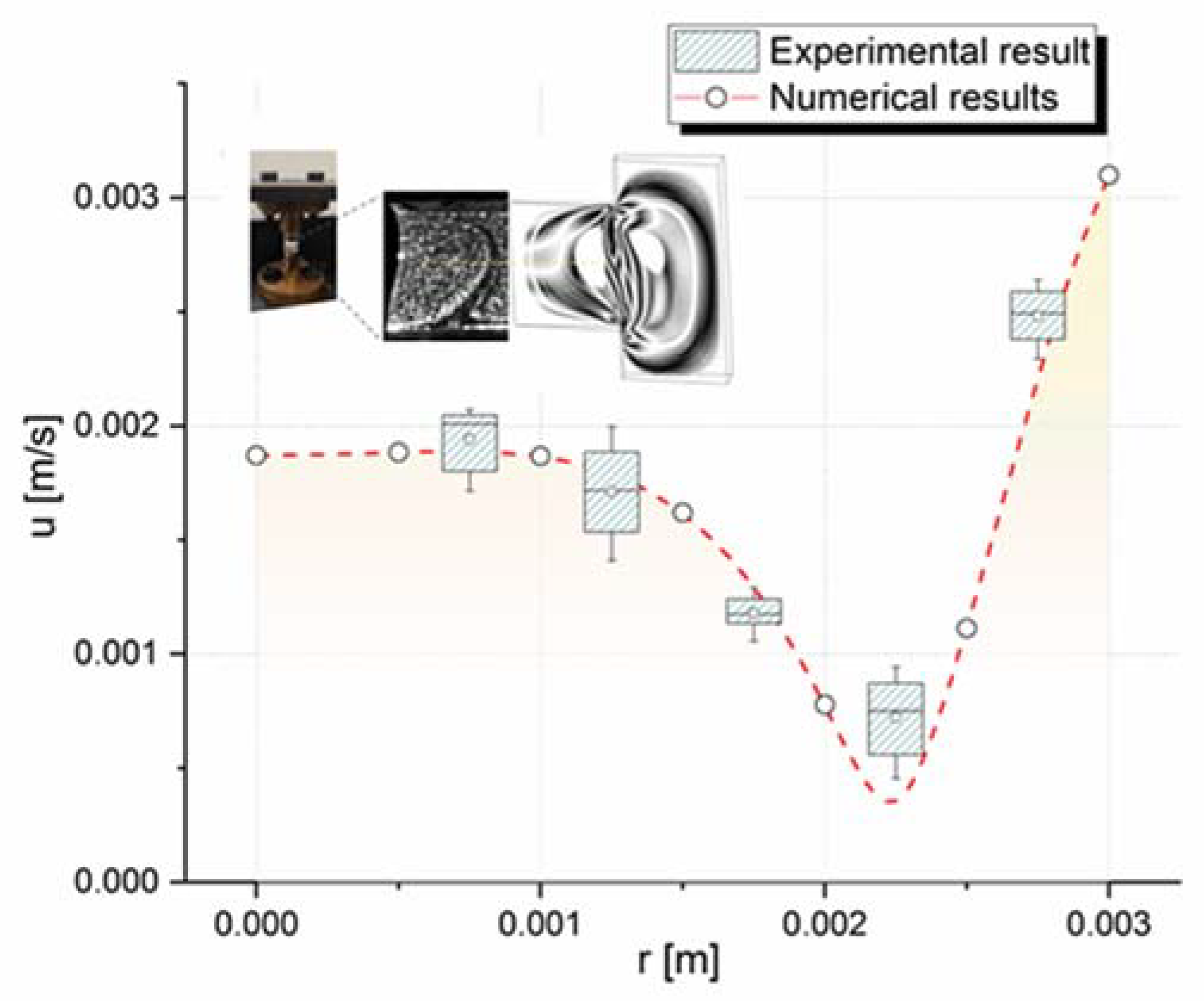


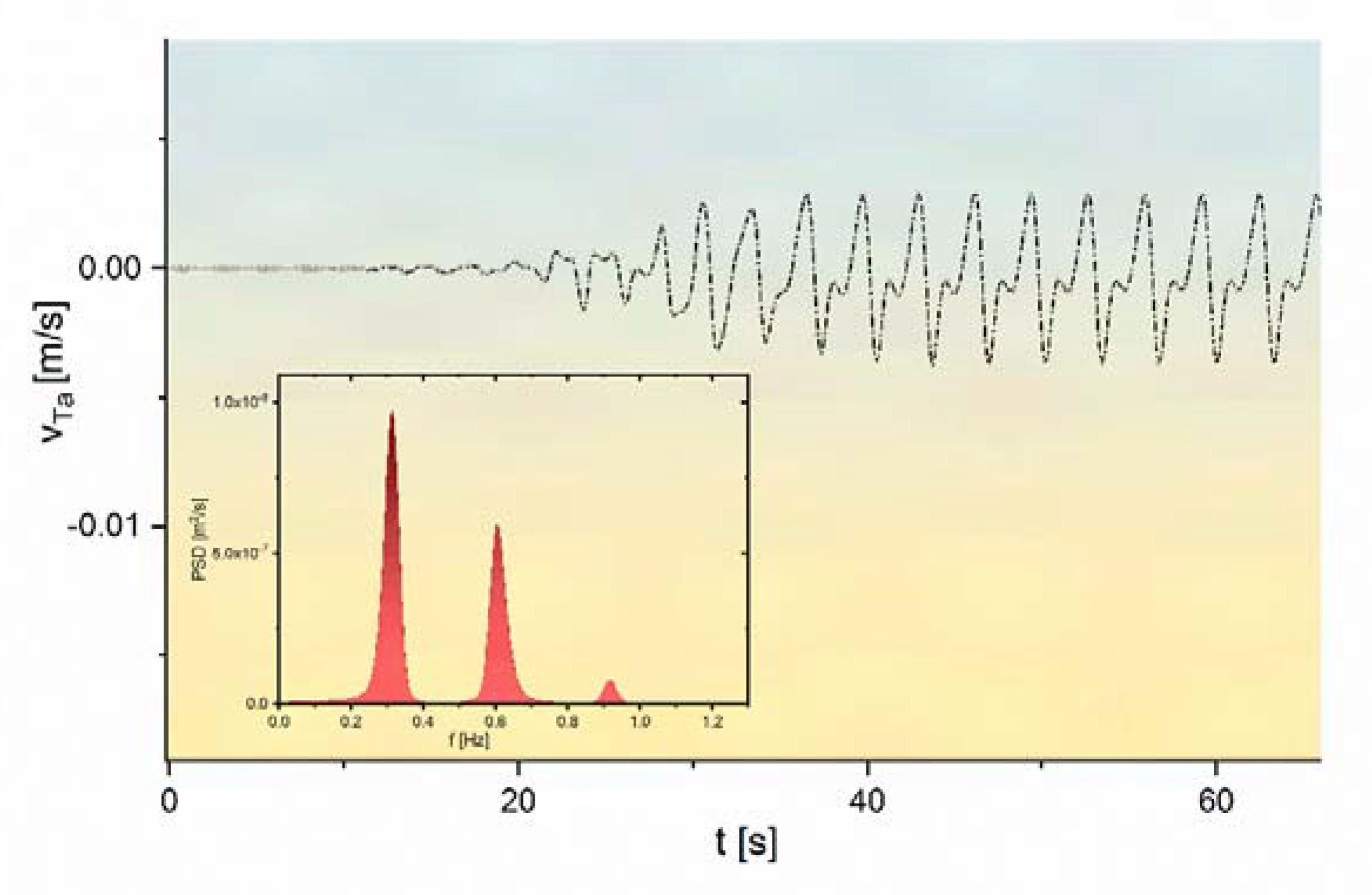

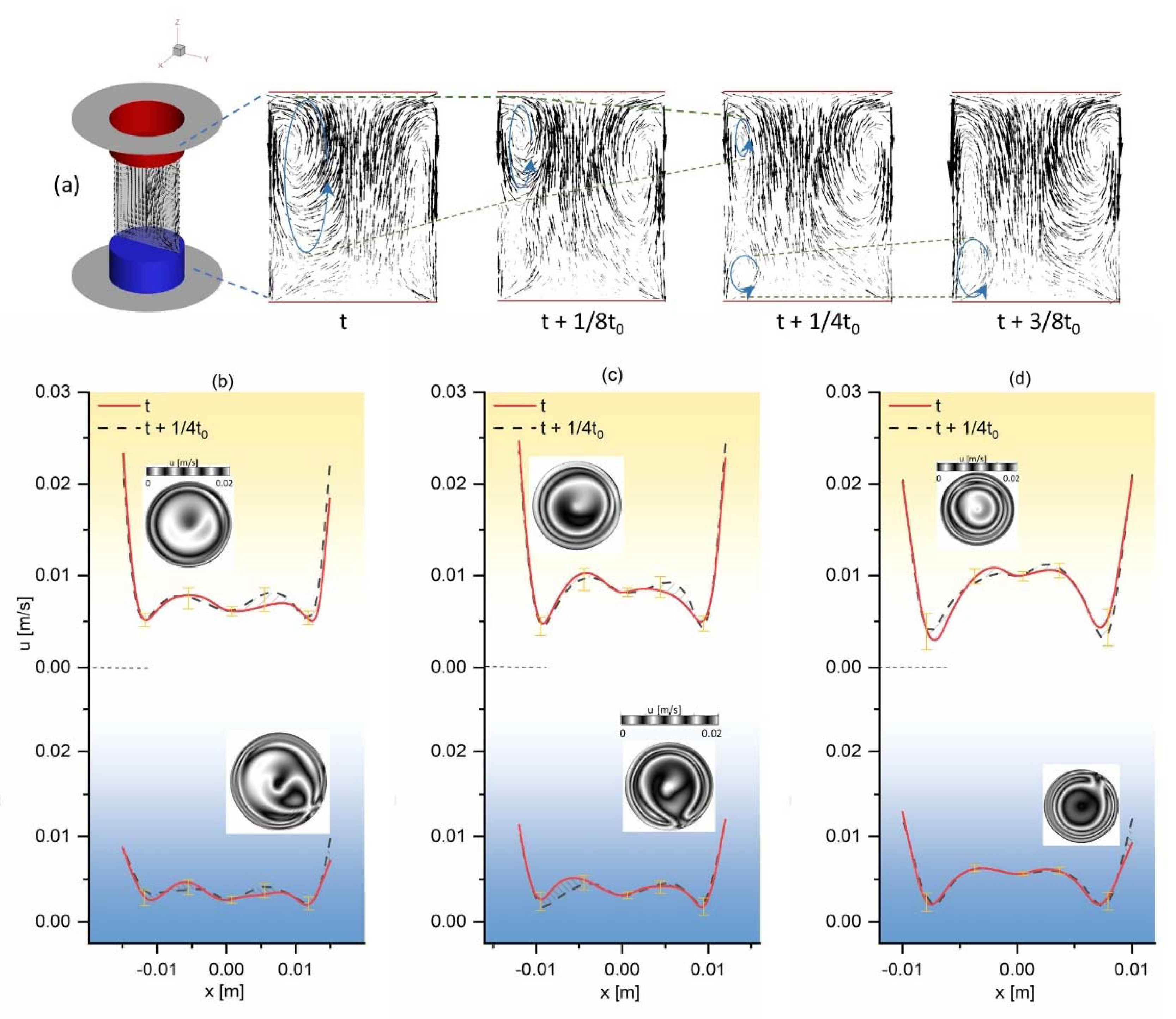
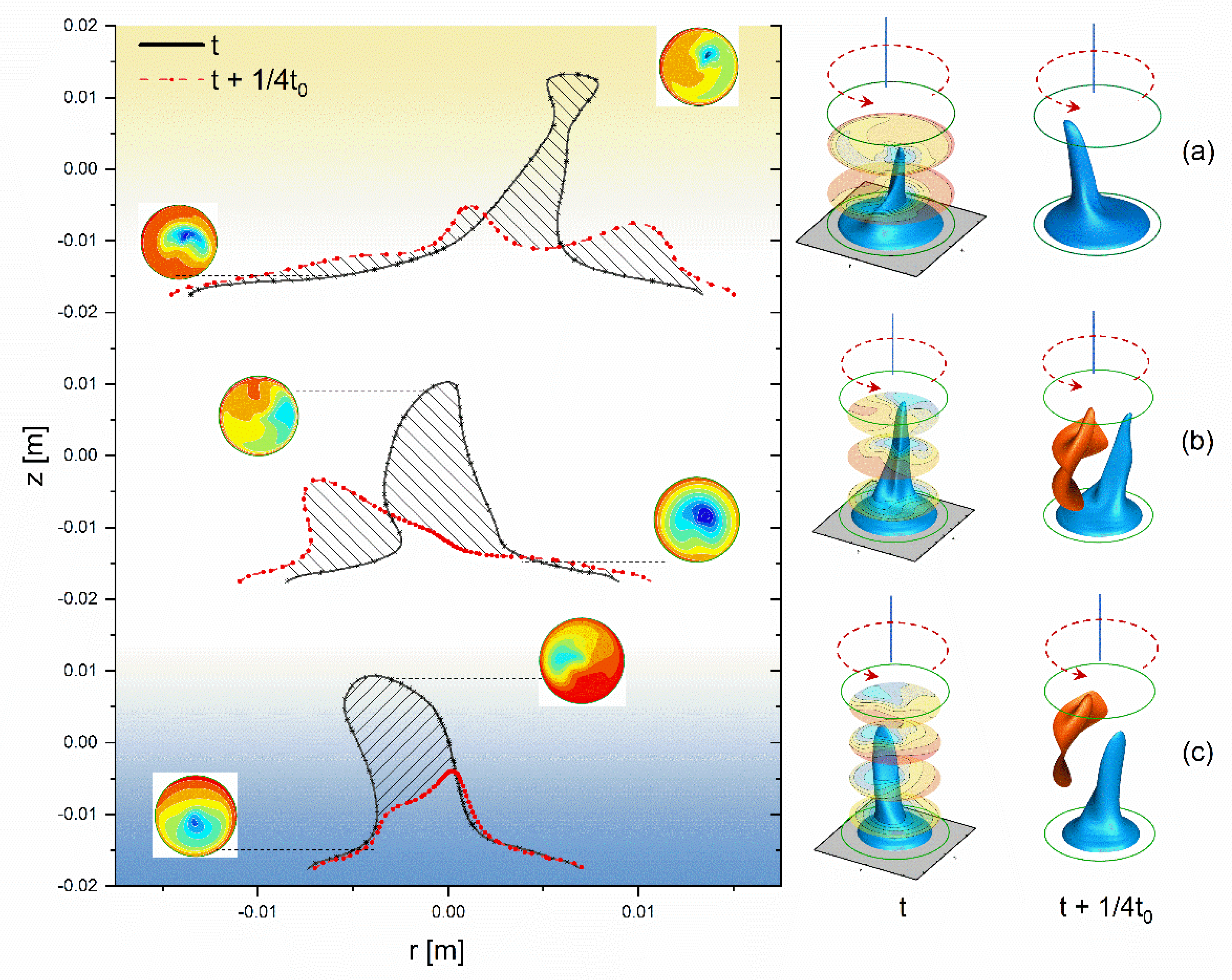





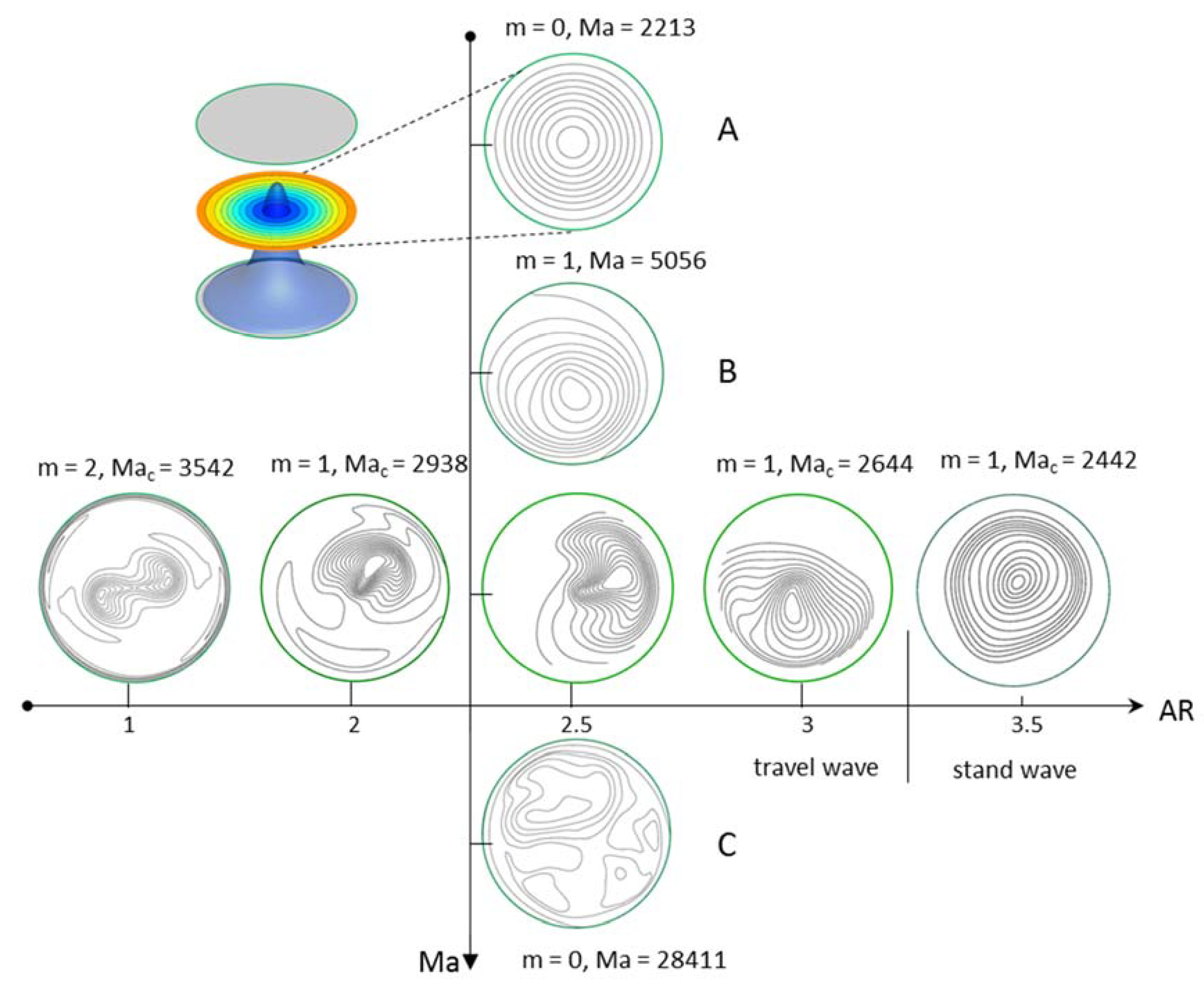
| Parameter | Silicon Melt | Argon |
|---|---|---|
| Prandtl number, Pr | 0.011 | 0.67 |
| Density, ρ (kg/m3) | 2530 | 1.63 |
| Kinematic viscosity, ν (m2/s) | 5.0 × 10−6 | 1.39 × 10−5 |
| Thermal diffusivity, α (m2/s) | 7.46 × 10−8 | 2.08 × 10−5 |
| Thermal conductivity, k [W/(mK)] | 0.12 | 0.018 |
| Specific heat, cp [J/(kgK)] | 1.76 × 103 | 5.22 × 102 |
| Temperature coefficient of surface tension, σT [N/(mK)] | −7 × 10−5 | - |
| Grid | T/K | u/(m·s−1) |
|---|---|---|
| 300,000 | 291.377 | 0.021 |
| 360,000 | 291.408 | 0.022 |
| 420,000 | 291.41 | 0.022 |
Publisher’s Note: MDPI stays neutral with regard to jurisdictional claims in published maps and institutional affiliations. |
© 2022 by the authors. Licensee MDPI, Basel, Switzerland. This article is an open access article distributed under the terms and conditions of the Creative Commons Attribution (CC BY) license (https://creativecommons.org/licenses/by/4.0/).
Share and Cite
Fan, J.; Liang, R. Numerical Simulation of Thermocapillary Convection in a Half-Zone Liquid Bridge Model with Large Aspect Ratio under Microgravity. Symmetry 2022, 14, 452. https://doi.org/10.3390/sym14030452
Fan J, Liang R. Numerical Simulation of Thermocapillary Convection in a Half-Zone Liquid Bridge Model with Large Aspect Ratio under Microgravity. Symmetry. 2022; 14(3):452. https://doi.org/10.3390/sym14030452
Chicago/Turabian StyleFan, Jungeng, and Ruquan Liang. 2022. "Numerical Simulation of Thermocapillary Convection in a Half-Zone Liquid Bridge Model with Large Aspect Ratio under Microgravity" Symmetry 14, no. 3: 452. https://doi.org/10.3390/sym14030452






